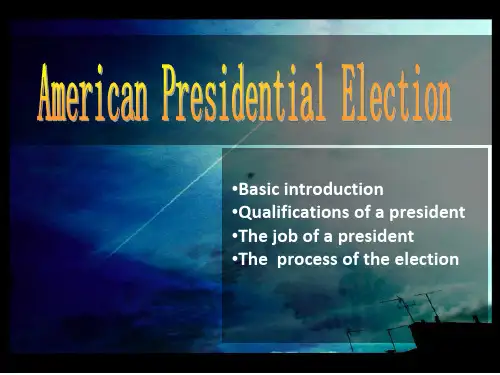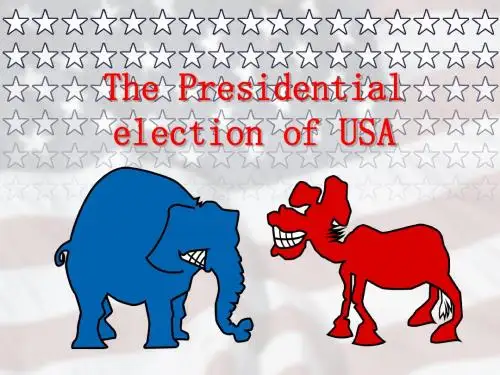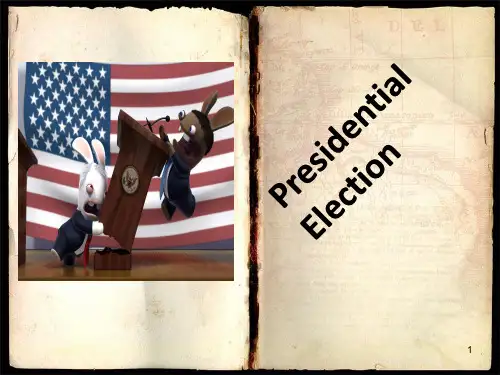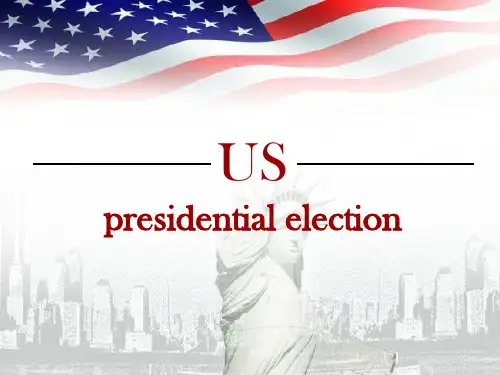美国总统大选选举程序英文课件
- 格式:ppt
- 大小:459.50 KB
- 文档页数:12

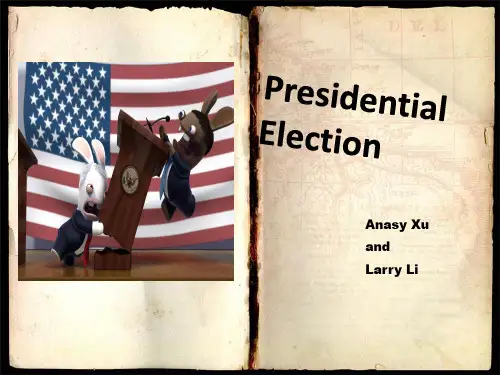
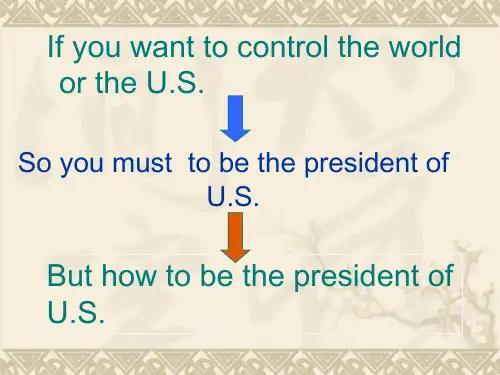
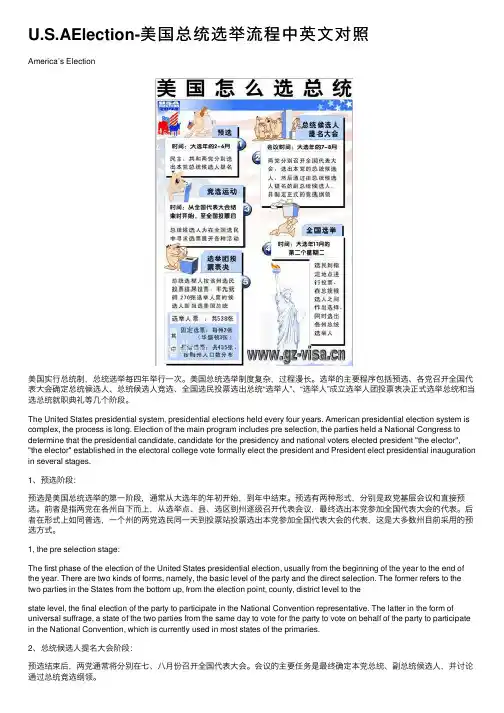
U.S.AElection-美国总统选举流程中英⽂对照America’s Election美国实⾏总统制,总统选举每四年举⾏⼀次。
美国总统选举制度复杂,过程漫长。
选举的主要程序包括预选、各党召开全国代表⼤会确定总统候选⼈、总统候选⼈竞选、全国选民投票选出总统“选举⼈”、“选举⼈”成⽴选举⼈团投票表决正式选举总统和当选总统就职典礼等⼏个阶段。
The United States presidential system, presidential elections held every four years. American presidential election system is complex, the process is long. Election of the main program includes pre selection, the parties held a National Congress to determine that the presidential candidate, candidate for the presidency and national voters elected president "the elector", "the elector" established in the electoral college vote formally elect the president and President elect presidential inauguration in several stages.1、预选阶段:预选是美国总统选举的第⼀阶段,通常从⼤选年的年初开始,到年中结束。
预选有两种形式,分别是政党基层会议和直接预选。
前者是指两党在各州⾃下⽽上,从选举点、县、选区到州逐级召开代表会议,最终选出本党参加全国代表⼤会的代表。
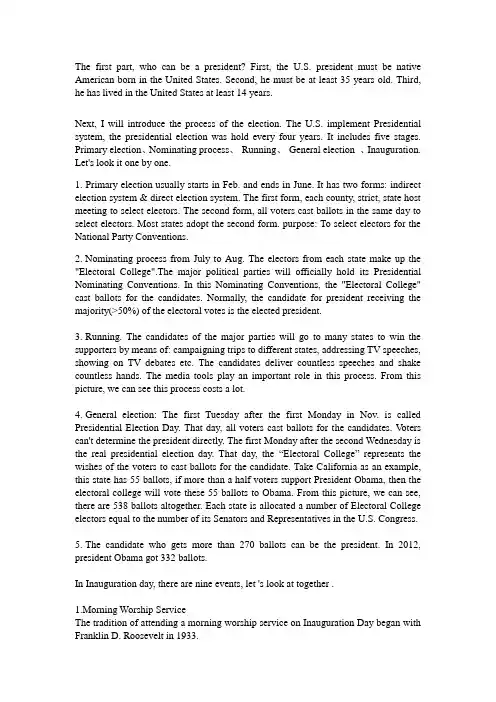
The first part, who can be a president? First, the U.S. president must be native American born in the United States. Second, he must be at least 35 years old. Third, he has lived in the United States at least 14 years.Next, I will introduce the process of the election. The U.S. implement Presidential system, the presidential election was hold every four years. It includes five stages. Primary election、Nominating process、Running、General election 、Inauguration. Let's look it one by one.1. Primary election usually starts in Feb. and ends in June. It has two forms: indirect election system & direct election system. The first form, each county, strict, state host meeting to select electors. The second form, all voters cast ballots in the same day to select electors. Most states adopt the second form. purpose: To select electors for the National Party Conventions.2.Nominating process from July to Aug. The electors from each state make up the "Electoral College".The major political parties will officially hold its Presidential Nominating Conventions. In this Nominating Conventions, the "Electoral College" cast ballots for the candidates. Normally, the candidate for president receiving the majority(>50%) of the electoral votes is the elected president.3.Running. The candidates of the major parties will go to many states to win the supporters by means of: campaigning trips to different states, addressing TV speeches, showing on TV debates etc. The candidates deliver countless speeches and shake countless hands. The media tools play an important role in this process. From this picture, we can see this process costs a lot.4.General election: The first Tuesday after the first Monday in Nov. is called Presidential Election Day. That day, all voters cast ballots for the candidates. V oters can't determine the president directly. The first Monday after the second Wednesday is the real presidential election day. That day, the “Electoral College”represents the wishes of the voters to cast ballots for the candidate. Take California as an example, this state has 55 ballots, if more than a half voters support President Obama, then the electoral college will vote these 55 ballots to Obama. From this picture, we can see, there are 538 ballots altogether. Each state is allocated a number of Electoral College electors equal to the number of its Senators and Representatives in the U.S. Congress.5.The candidate who gets more than 270 ballots can be the president. In 2012, president Obama got 332 ballots.In Inauguration day, there are nine events, let 's look at together .1.Morning Worship ServiceThe tradition of attending a morning worship service on Inauguration Day began with Franklin D. Roosevelt in 1933.2.Procession to the CapitolBy tradition, the outgoing President accompanies the President-elect to the Capitol for the swearing-in ceremony.3.Vice President’s Swearing-In CeremonyUntil 1937, the Vice President was sworn into office in the Senate.4.President’s Swearing-In Ceremony5.Inaugural AddressSince George Washington in 1789, every President has delivered an Inaugural address.6.Departure of the Outgoing PresidentFollowing the inaugural ceremony on the west front of the U.S. Capitol, the outgoing President and First Lady leave the Capitol to begin their post-presidential lives.7.Inaugural LuncheonSince 1953, a luncheon was hosted at the U.S. Capitol for the new President, Vice President, and guests.8.Inaugural ParadeWhile early parades were mostly military escorts, by 1841, floats, citizens groups, and bands became standard.9.Inaugural BallThe first Inaugural ball in Washington was thrown for James and Dolley Madison in 1809.The final part is presidential oath. Firstly, I will introduce some details about the oath. Later, I will show you a short video about the oath of the president Obama.1.Presidents say their name after the first " I"2.Presidents raise their right hand and put their left hand on the bible while swearing in.3.The Chief Justice of the Supreme Court(最高法院首席法官) swears in the President of the United States.4.The swearing in ceremony was held in Washington, D.C.5.It is customary for presidents to add the words "So help me God " to the end of the oath .6.Presidents give an inaugural speech after their oath.。
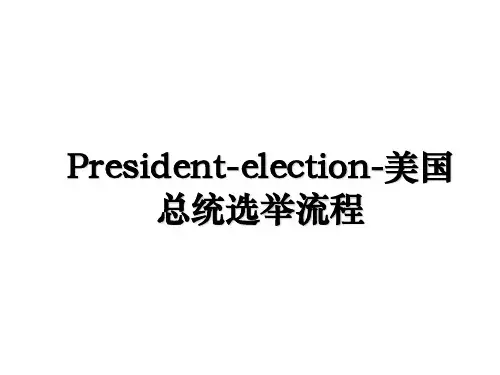
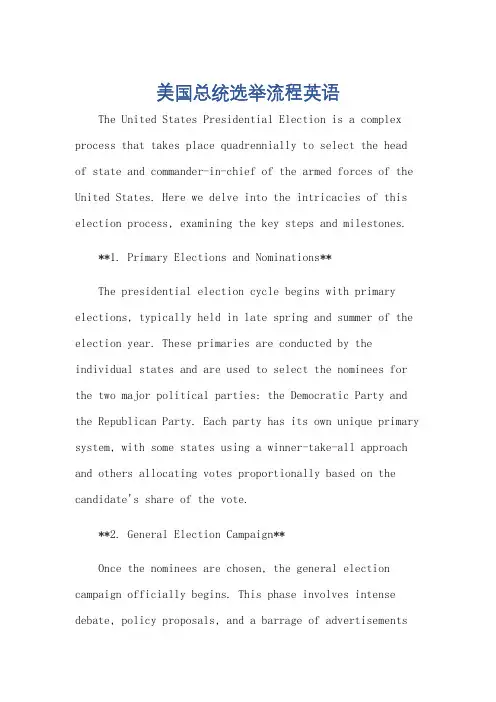
美国总统选举流程英语The United States Presidential Election is a complex process that takes place quadrennially to select the head of state and commander-in-chief of the armed forces of the United States. Here we delve into the intricacies of this election process, examining the key steps and milestones. **1. Primary Elections and Nominations**The presidential election cycle begins with primary elections, typically held in late spring and summer of the election year. These primaries are conducted by the individual states and are used to select the nominees for the two major political parties: the Democratic Party and the Republican Party. Each party has its own unique primary system, with some states using a winner-take-all approach and others allocating votes proportionally based on the candidate's share of the vote.**2. General Election Campaign**Once the nominees are chosen, the general election campaign officially begins. This phase involves intense debate, policy proposals, and a barrage of advertisementsand public appearances by the candidates. Both candidates engage in a series of debates, which are broadcast nationwide and provide an opportunity for the American people to hear directly from the nominees about theirvision for the country.**3. Voting Day**On Election Day, citizens of the United States cast their votes for president. The Election Day is always a Tuesday and is typically held in November of the election year. Voting takes place at designated polling stations throughout the country, and citizens can register to vote as long as they are US citizens, at least 18 years old, and have resided in their voting district for a certain period of time.**4. Electoral College**A unique feature of the American presidential election is the Electoral College. After the votes are cast, the elected officials of each state, known as electors, cast their votes for president. Each state is allocated a number of electors equal to the total number of senators and representatives it has in Congress. The candidate whoreceives a majority of the votes in a state wins all the electors from that state.**5. Counting the Votes and Inauguration**Once all the votes are cast and the electors have voted, the votes are tallied. The candidate who receives amajority of the votes cast by the electors becomes the president-elect. If no candidate receives a majority, the House of Representatives votes to select the president,with each state casting a single vote. The newly elected president is then sworn in during a ceremony known as the Inauguration, typically held in January of the yearfollowing the election.The presidential election process in the United Statesis a robust democratic mechanism that ensures the peaceful transfer of power and the representation of the will of the American people. From the primaries to the inauguration, it is a testament to the resilience and durability of American democracy.**美国总统选举流程深度解析**美国总统选举是一个每四年举行一次的重要过程,旨在选举出美国的国家元首和武装部队的总司令。
